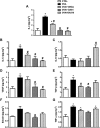The tyrosine kinase inhibitor dasatinib reduces lung inflammation and remodelling in experimental allergic asthma
- PMID: 26989986
- PMCID: PMC5341339
- DOI: 10.1111/bph.13430
The tyrosine kinase inhibitor dasatinib reduces lung inflammation and remodelling in experimental allergic asthma
Abstract
Background and purpose: Asthma is characterized by chronic lung inflammation and airway hyperresponsiveness. Despite recent advances in understanding of its pathophysiology, asthma remains a major public health problem, and new therapeutic strategies are urgently needed. In this context, we sought to ascertain whether treatment with the TK inhibitor dasatinib might repair inflammatory and remodelling processes, thus improving lung function, in a murine model of asthma.
Experimental approach: Animals were sensitized and subsequently challenged, with ovalbumin (OVA) or saline. Twenty-four hours after the last challenge, animals were treated with dasatinib, dexamethasone, or saline, every 12 h for 7 consecutive days. Twenty-four hours after the last treatment, the animals were killed, and data were collected. Lung structure and remodelling were evaluated by morphometric analysis, immunohistochemistry, and transmission electron microscopy of lung sections. Inflammation was assessed by cytometric analysis and ELISA, and lung function was evaluated by invasive whole-body plethysmography.
Key results: In OVA mice, dasatinib, and dexamethasone led to significant reductions in airway hyperresponsiveness. Dasatinib was also able to attenuate alveolar collapse, contraction index, and collagen fibre deposition, as well as increasing elastic fibre content, in OVA mice. Concerning the inflammatory process, dasatinib reduced inflammatory cell influx to the airway and lung-draining mediastinal lymph nodes, without inducing the thymic atrophy promoted by dexamethasone.
Conclusions and implications: In this model of allergic asthma, dasatinib effectively blunted the inflammatory and remodelling processes in asthmatic lungs, enhancing airway repair and thus improving lung mechanics.
© 2016 The British Pharmacological Society.
Figures







References
-
- Abreu SC, Antunes MA, de Castro JC, de Oliveira MV, Bandeira E, Ornellas DS, et al. (2013). Bone marrow‐derived mononuclear cells vs. mesenchymal stromal cells in experimental allergic asthma. Respir Physiol Neurobiol 187: 190–198. - PubMed
-
- Abreu SC, Antunes MA, Maron‐Gutierrez T, Cruz FF, Carmo LG, Ornellas DS, et al. (2011). Effects of bone marrow‐derived mononuclear cells on airway and lung parenchyma remodeling in a murine model of chronic allergic inflammation. Respir Physiol Neurobiol 175: 153–163. - PubMed
-
- Barnes PJ (2013). New anti‐inflammatory targets for chronic obstructive pulmonary disease. Nat Rev Drug Discov 12: 543–559. - PubMed
-
- Barnes PJ (2012). Severe asthma: advances in current management and future therapy. J Allergy Clin Immunol 129: 48–59. - PubMed
Publication types
MeSH terms
Substances
LinkOut - more resources
Full Text Sources
Other Literature Sources
Medical

